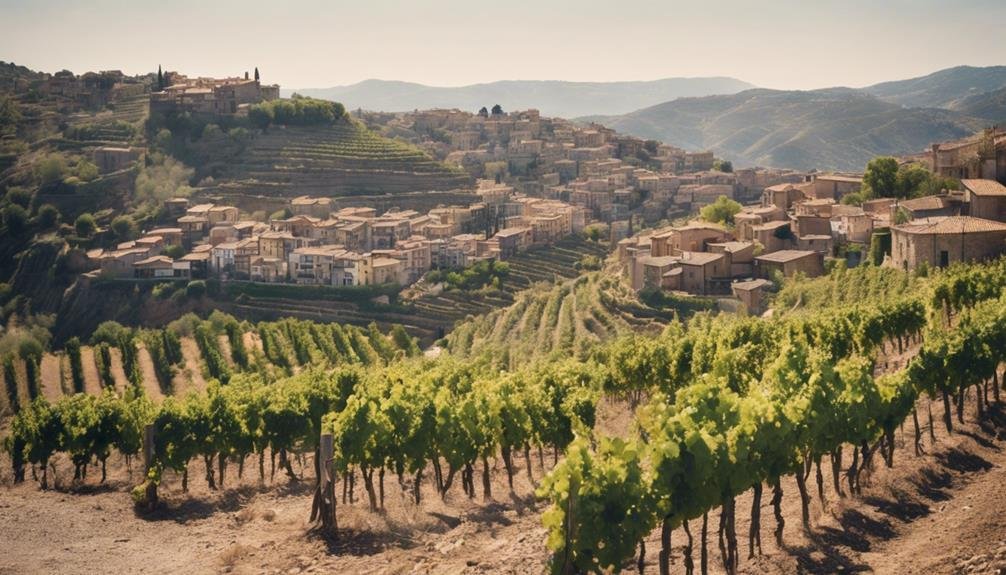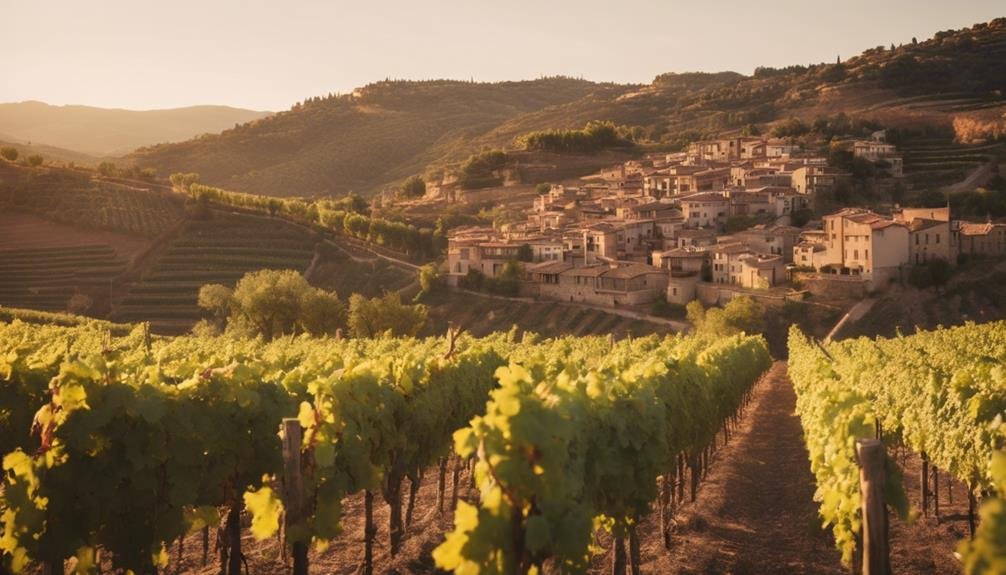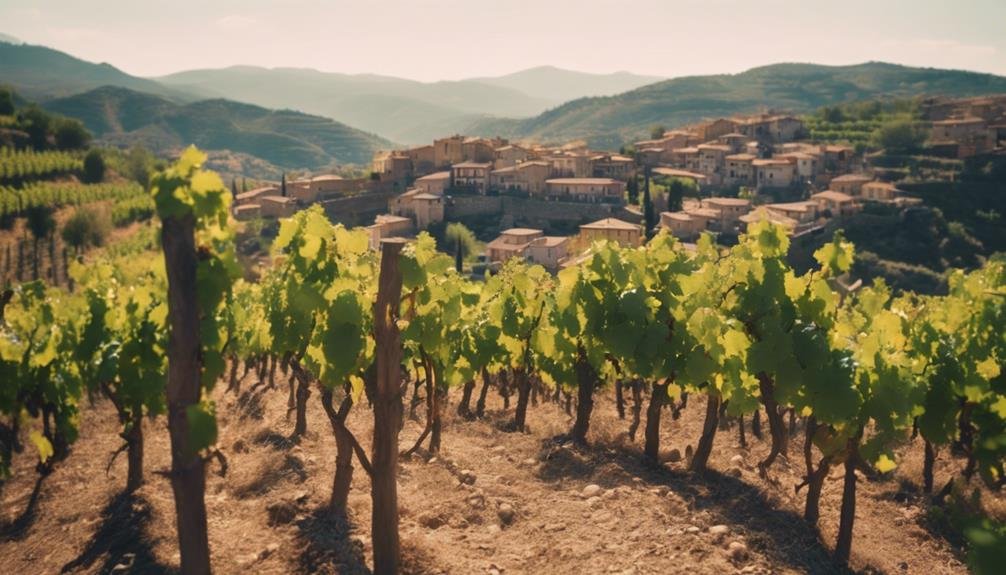The remarkable rise of Priorat wines showcases centuries-old winemaking traditions merging with modern innovations, culminating in unrivaled excellence. Renowned pioneers like René Barbier have reshaped Priorat, emphasizing its unique terroir and commitment to sustainable practices. These wines boast bold flavors influenced by distinctive slate soils and steep terraced vineyards, with a complexity that includes saline and spiced notes, ideal for pairing with rich dishes. Positioned in the premium market segment, Priorat wines typically range from $40-$60, reflecting their sought-after status among connoisseurs worldwide. The future holds promising prospects, focusing on sustainability and global expansion to introduce Priorat's excellence to new audiences.
Historical Evolution of Priorat Wines
The historical evolution of Priorat wines traces back to the 12th century when winemaking began in the region, laying the foundation for its esteemed reputation today.
Over the centuries, Priorat wines have experienced a resurgence, with modern-day innovations enhancing their quality and global recognition.
The journey of Priorat wines from their 12th-century origins to the present showcases a remarkable transformation fueled by dedication and expertise.
The recent decades have seen a revival of winemaking practices and techniques, leading to the production of exceptional wines that have garnered acclaim worldwide.
The fusion of traditional methods with contemporary approaches has elevated Priorat wines to new heights, solidifying their status as a symbol of excellence in the world of winemaking.
Key Players in Priorats Renaissance
Emerging from the historical evolution of Priorat wines, the key players in Priorat's renaissance have been instrumental in reshaping the region's winemaking landscape and propelling it to international acclaim. Winemaking pioneers like René Barbier and other visionaries played a pivotal role in reviving Priorat's reputation by introducing modern techniques and quality standards.
Their dedication to highlighting the unique terroir influence of Priorat, characterized by the region's distinctive slate soil and steep terraced vineyards, has elevated Priorat wines to a prestigious status. Through their commitment to sustainable viticulture practices and a deep understanding of the land, these key players have established Priorat as a powerhouse in the world of fine wines, attracting connoisseurs and enthusiasts seeking exceptional quality and distinctiveness.
Signature Traits of Priorat Wines

Known for their distinctive characteristics and unparalleled quality, Priorat wines stand out in the world of fine wines. These wines exhibit a unique combination of traits that set them apart from others, making them highly sought after by connoisseurs worldwide. The table below outlines some of the signature traits of Priorat wines:
| Signature Traits of Priorat Wines | |
|---|---|
| Terroir Influence | Bold and Distinct |
| Flavor Complexity | Saline and Spiced |
| Aging Potential | Excellent |
| Food Pairings | Rich dishes, Game |
The terroir influence in Priorat wines contributes to their bold and distinct flavors, offering a complex profile of saline and spiced notes. These wines have excellent aging potential, making them suitable for long-term cellaring, and pair exceptionally well with rich dishes and game meats.
Market Positioning and Pricing Trends
Building on the distinct traits that define Priorat wines, an exploration of the market positioning and pricing trends of these exceptional wines reveals valuable insights into their place in the global wine industry. Priorat wines are positioned in the premium market segment, reflecting their exceptional quality and unique terroir.
Consumer preferences for complex, bold wines with distinctive minerality and herbal finishes have driven the reputation of Priorat wines as some of Spain's finest and most sought-after. Prices for quality Priorat wines typically range from $40-$60, with top producers commanding even higher prices due to their renowned excellence.
This pricing trend underscores the perceived value and craftsmanship associated with Priorat wines, solidifying their status as premium offerings in the competitive wine market.
Future Prospects for Priorat Wines

The evolution of Priorat wines is poised to continue enhancing their standing in the global wine market. With a focus on sustainability initiatives and global market expansion, Priorat wineries are set to further augment their reputation.
By implementing sustainable practices in vineyard management and production processes, Priorat aims to preserve its unique terroir for future generations while meeting the growing demand for eco-conscious products.
Additionally, the ongoing efforts to expand into new international markets will introduce a broader audience to the exceptional quality and distinct characteristics of Priorat wines.
These strategic moves towards sustainability and global reach are expected to solidify Priorat's position as a premier wine region, offering unparalleled wines that reflect both tradition and innovation.
Frequently Asked Questions
What Traditional Winemaking Techniques Are Still Used in Priorat?
In Priorat, ancient winemaking techniques like terracing and hand-harvesting persist alongside modern innovations. Soil influences grape varieties, with Garnacha and Cariñena being prominent. This harmonious blend of tradition and innovation shapes the distinctive flavors of Priorat wines.
How Has Climate Change Affected Priorats Vineyards?
Climate change has impacted Priorat's vineyards, testing the resilience of vines. Rising temperatures alter grape ripening, challenging winemakers. Despite adversities, innovative practices and adaptability demonstrate the vineyards' capacity to evolve and produce exceptional wines.
What Is the Significance of the Village Names in Priorats Sub-Zones?
The significance of village names in Priorat's sub-zones lies in their portrayal of unique terroir influence and vineyard management practices. Each village symbolizes distinct characteristics and quality control measures that shape the region's diverse wine styles.
Are There Any Sustainability Practices Adopted by Priorat Wineries?
Priorat wineries follow eco-friendly practices like organic farming, emphasizing sustainability. They prioritize water conservation and may utilize renewable energy sources. These efforts showcase a commitment to environmental stewardship in the winemaking process.
How Do Priorat Wines Compare to Other Spanish Wine Regions in Terms of Aging Potential?
In comparing aging potential, Priorat wines, influenced by unique terroir and grape varietals like Garnacha and Cariñena, stand out with bold tannins, high alcohol content, and complex flavor profiles. They exhibit exceptional aging characteristics, distinguishing them from other Spanish regions.
Conclusion
To sum up, the rise of Priorat wines showcases a remarkable journey from historical roots to modern success.
One interesting statistic is that Priorat wines have seen a 60% increase in exports over the past decade, highlighting their growing popularity on the global stage.
With a perfect blend of tradition, innovation, and terroir, Priorat wines continue to captivate wine enthusiasts worldwide with their unique characteristics and exceptional quality.
